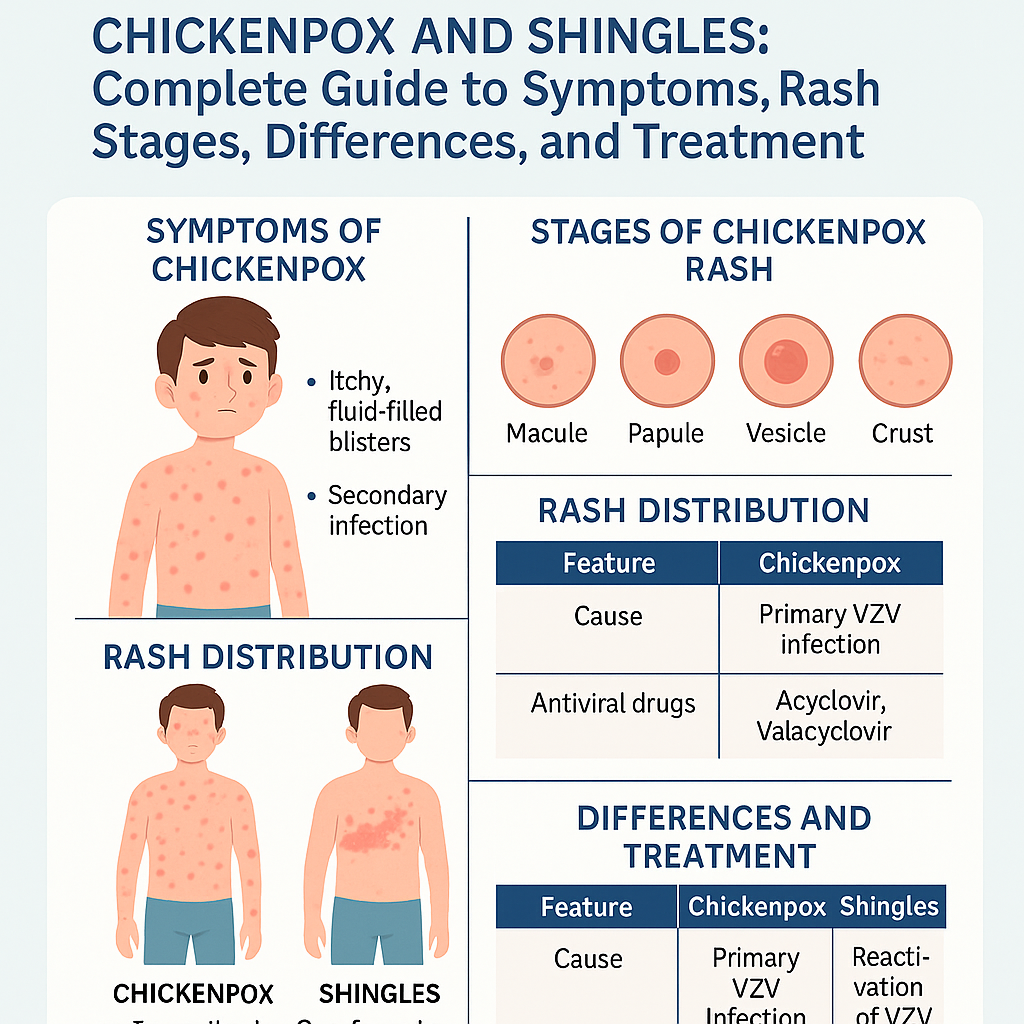Chickenpox and Shingles: 7 Essential Facts You Must Know About VZV Infection
A Simple and Clear Guide to Chickenpox and Shingles for Everyone
Focus Keyword: Chickenpox and Shingles
Overview
Chickenpox and Shingles are caused by the same virus: Varicella-Zoster Virus (VZV), also known as Human Herpesvirus 3 (HHV-3).
- Chickenpox (Varicella): The first infection, mostly in children.
- Shingles (Herpes Zoster): A later reactivation of the virus in nerve cells.
How Chickenpox Spreads
- Spread starts 48 hours before the rash and continues until all blisters crust over.
- Spread by:
- Direct contact with blister fluid
- Airborne droplets from coughing or sneezing
Symptoms of Chickenpox
- Itchy, fluid-filled blisters (vesicular rash)
- Secondary bacterial infection can occur if scratched
Stages of Chickenpox Rash
- Macules: Flat, red spots
- Papules: Raised bumps
- Vesicles: Fluid-filled blisters
- Pustules: Pus-filled blisters
- Crusts: Lesions dry and scab over
Note: Lesions appear in crops and all stages can be seen simultaneously.
Rash Distribution
- Chickenpox: Generalized rash affecting face, trunk, scalp, and extremities.
- Shingles: Rash limited to a single dermatome, does not cross the body’s midline.
Severity Difference
- Mild in children
- More severe in adults, pregnant women, and immunocompromised people
Serious Complications
- Varicella Pneumonitis (lung infection)
- Hepatitis (liver infection)
- Encephalitis (brain infection)
Differential Diagnosis of Chickenpox
- Smallpox: Lesions are in the same stage and mostly affect face and extremities.
- Hand, Foot, and Mouth Disease: Lesions on hands, feet, and mouth.
- Impetigo: Honey-colored crusts with no systemic symptoms.
- Insect Bites: Itchy papules, no fever, no vesicle-crust progression.
Diagnosis of Chickenpox
- Mainly clinical
- Confirmed by:
- Direct Immunofluorescence Test (DFA)
- PCR test from blister fluid
- Serology (IgG blood test)
Chickenpox Treatment
- Acyclovir: 800 mg, 5 times daily for 5 days
- Alternative drugs: Famciclovir, Valacyclovir
- For Immunocompromised Patients:
- IV Acyclovir: 10 mg/kg every 8 hours until improvement
- Then switch to oral therapy
Shingles (Herpes Zoster)
What is Shingles?
- Reactivation of the Chickenpox virus later in life
- Causes burning pain and rash in a single dermatome
- Rash does not cross the midline
Symptoms
- Pain, burning, tingling
- Rash in a single dermatome
- Sometimes nerve pain without rash (Zoster sine herpete)
Complications
- Ramsay Hunt Syndrome: Ear rash, facial weakness, loss of taste, mouth ulcers
- Myelitis or Encephalitis (spinal cord or brain infection)
- Post-Herpetic Neuralgia (PHN): Treated with Gabapentin, Amitriptyline, Pregabalin
- Ophthalmic Zoster: Eye involvement requiring urgent care
Shingles Treatment
- Same antiviral drugs as Chickenpox
- Duration: 7 to 10 days
- Early treatment reduces PHN risk
Diagnosis of Shingles
- Mainly clinical
- Confirmed by PCR or DFA if needed
Chickenpox and Shingles Vaccination
Who Should Get Vaccinated?
- Close Contacts:
- Household exposure (>15 minutes)
- Hospital exposure
- Sexual partners
- Newborn exposure
- High-Risk Groups:
- Immunocompromised patients
- Pregnant women
- Babies and small children
- Serology Check:
- Negative IgG: Needs vaccination
- Positive IgG: Already immune
Additional Prevention
- Post-Exposure Prophylaxis (PEP): Varicella-Zoster Immunoglobulin (VZIG)
- Shingles Vaccine: Shingrix preferred over Zostavax, recommended for adults over 50
Special Notes
- Newborns exposed within 5 days before or 2 days after maternal Chickenpox are at high risk
- Shingles is less contagious than Chickenpox
- Second attacks of Chickenpox are extremely rare
Difference Between Chickenpox and Shingles
| Feature | Chickenpox | Shingles |
|---|---|---|
| Cause | Primary VZV infection | Reactivation of VZV |
| Rash Distribution | Generalized (face, trunk, scalp, extremities) | Limited to one dermatome |
| Rash Pattern | All stages of rash appear simultaneously | Rash follows a single nerve path, does not cross midline |
| Contagiousness | Highly contagious | Less contagious, requires direct contact with vesicle fluid |
| Common Age Group | Mostly children | Mostly adults, especially over 50 |
| Recurrence | Rare | Can recur if immunity is weak |

Key Takeaways
- Chickenpox is the first VZV infection; Shingles is a later reactivation
- Chickenpox is usually mild in children but can be severe in adults
- Both can cause serious complications
- Early treatment and vaccination are essential for protection
Recommended External Resources
For more comprehensive and up-to-date information about Chickenpox and Shingles, please explore the following trusted medical sources:
- Centers for Disease Control and Prevention (CDC): Detailed guidelines on symptoms, prevention, vaccination, and management of Chickenpox and Shingles. Visit CDC Chickenpox and Shingles Page
- World Health Organization (WHO): Global perspective on Varicella and Herpes Zoster outbreaks, prevention strategies, and vaccination updates. Visit WHO Chickenpox and Shingles Fact Sheet
- Mayo Clinic: Patient-friendly information on causes, symptoms, treatment options, and recovery tips for Chickenpox and Shingles. Visit Mayo Clinic Shingles Page














